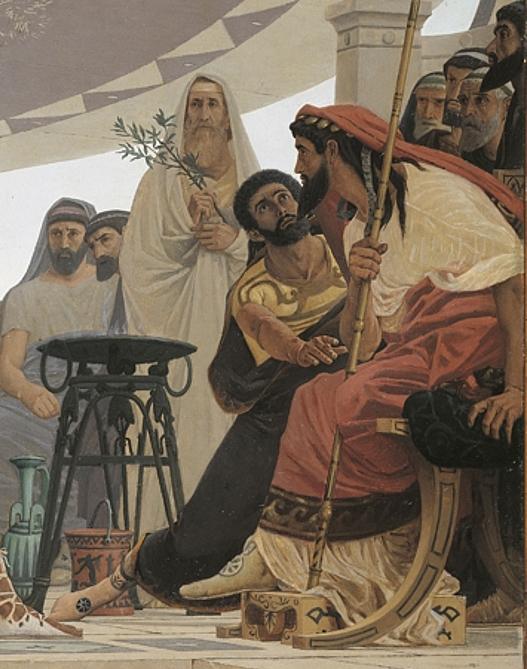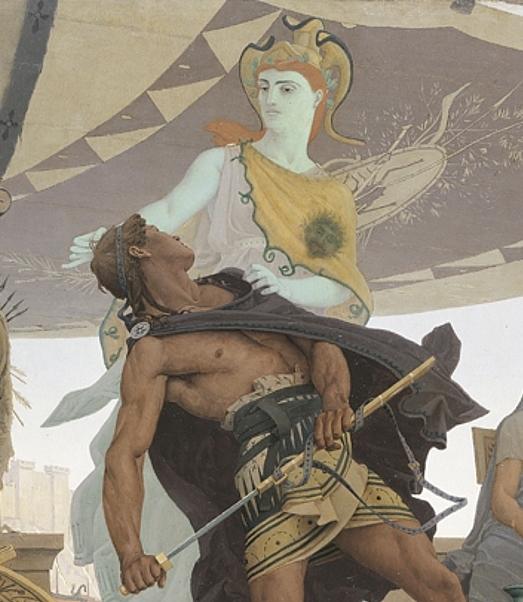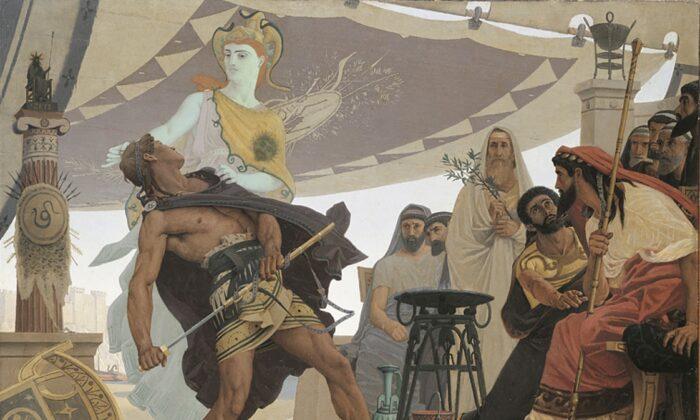Have you ever had a moment when you felt anger rise from the pit of your stomach? Maybe someone did something or said something that really made you angry, and you could feel yourself about to do something that you might regret one day; but, instead, you stopped yourself.
The painting “The Wrath of Achilles” by French painter Louis Edouard Fournier reminds me that there’s wisdom in the type of restraint I just described.
The Anger Between Achilles and Agamemnon
As legend has it, Achilles was the seemingly invincible warrior fighting for King Agamemnon and the Greeks in the Trojan War. Achilles, efficient at his job, sacked 12 cities around Troy during the first nine years of the war. However, Achilles and Agamemnon did not always get along. In one particular moment in Greek mythology, the two were at odds.In the 10th year of the war, Agamemnon took the daughter of an Apollonian priest as a prize of war. The priest went to Agamemnon to request the return of his daughter, but Agamemnon refused. For his refusal, the priest prayed to Apollo to curse the Greeks with a plague. Afterward, a plague did haunt the people of Greece.
The goddess Hera inspired Achilles to inquire about the source of the plague. All of the Greeks believed that the plague was sacred, that is, that the gods were punishing them. A seer told Achilles that Apollo caused the plague because Agamemnon kept the Apollonian priest’s daughter prisoner. To stop the plague, Agamemnon must return the girl and perform certain rituals.
Upon hearing this revelation, Agamemnon became angry and insulted the seer. The Greeks, however, fearing the plague, demanded that Agamemnon return the girl to her father. Agamemnon agreed but only if he was granted another girl to replace her.
Agamemnon’s greed angered Achilles, and Achilles publicly criticized Agamemnon. In response to the criticism, Agamemnon demanded Achilles’s own slave as a replacement. Enraged, Achilles reached for his sword to take Agamemnon’s life.
Hera, however, loving both Achilles and Agamemnon, sent the goddess Athena to Achilles to encourage him to restrain himself. If he practiced restraint, Athena promised him a great future reward. Achilles agreed and put his sword away.
The counselor Nestor tried to advise Agamemnon and Achilles toward a compromise for the benefit of all of Greece, but the two men were too angry. Achilles left, and Agamemnon later sent men to Achilles to acquire his new female companion. Achilles gave his slave to Agamemnon, but, at least for a while, refused to fight in the war.
‘The Wrath of Achilles’
In his painting “The Wrath of Achilles,” Fournier depicted the moment that Athena intervenes between Achilles and Agamemnon.Athena and Achilles occupy the left side of the composition. Achilles leans back with his muscles tense as he unsheathes his sword. The black of his cloak contrasts with the alabaster white skin of Athena. Achilles’s anxious and angry energy also contrasts with Athena’s calm demeanor: Athena gently places one hand on Achilles’s shoulder, and she holds a lock of his hair with her other hand as she encourages him to restrain himself.
Sitting at the right side of the composition, dressed in red and white, is Agamemnon. The king holds a scepter in his hand, which signifies his status, and he leans toward Achilles—blind to Athena—with a watchful eye.
We can assume that Nestor is at the side of Agamemnon. Nestor has a concerned look on his face and reaches toward Agamemnon as if he is pleading for him to compromise. Behind Nestor is the seer, who is dressed in priestly garb. The seer calmly watches Achilles.

The Power of Restraint
There is wisdom in restraint, and I think Fournier’s depiction gives us a visual example of this wisdom.Fournier depicted every muscle in Achilles’s body as tight and tense. We can feel the stress coursing through his body. It’s ironic how one of the most powerful warriors in Greek mythology almost loses power over himself. He almost lets his anger get the best of him. Can anger, when left unrestrained, cause stress in our lives and on our bodies?
Achilles is not the only one under stress, however. Both Agamemnon and Nestor appear in nearly the same state. Agamemnon, tightly clenching his scepter and holding onto his chair, seems unsure about Achilles’s intentions. Nestor seems to be stressed by the anger between the two men.
The only two prominent figures who appear calm are Athena and the seer. As a communicator with the gods, the seer seems to understand that whatever happens is the will of the gods. He, therefore, shows little emotion or concern but simply watches the scene unfold.
Athena appears to accomplish much with little effort. Fournier did well in depicting her presence as a restrained contrast to that of Achilles. It’s difficult to tell if Achilles is leaning back to unsheathe the sword of his own will or if the touch of the goddess bends his body back against his will. I’m going to go with the latter.
With one hand gently placed on Achilles’s shoulder and with a lock of hair held between her index finger and thumb, Athena restrains one of the most accomplished warriors in Greek mythology. She tells Achilles that there’s a greater reward for his restraint than for his wrath.

Athena’s presence suggests that calm restraint accomplishes more than violent wrath, that there’s more in it for us if we are calm and restrained than angry and unhinged.
How might we, when we feel anger rising from the pit of our stomach, remember to remain calm? How might we, in our own best interest, tap into the power of restraint?
The traditional arts often contain spiritual representations and symbols the meanings of which can be lost to our modern minds. In our series “Reaching Within: What Traditional Art Offers the Heart,” we interpret visual arts in ways that may be morally insightful for us today. We do not assume to provide absolute answers to questions generations have wrestled with, but hope that our questions will inspire a reflective journey toward our becoming more authentic, compassionate, and courageous human beings.
Eric Bess is a practicing representational artist and is a doctoral candidate at the Institute for Doctoral Studies in the Visual Arts (IDSVA).






Friends Read Free